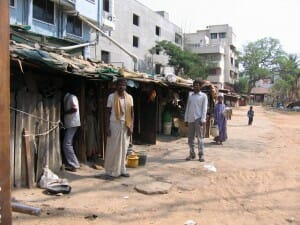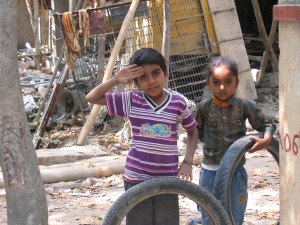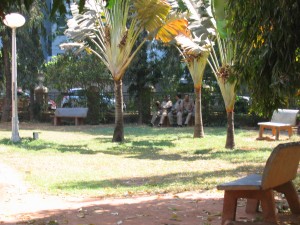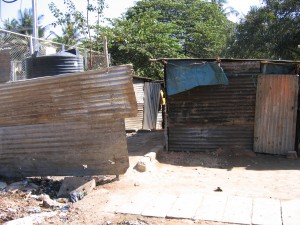
Shacks Next to Buildings
Years after my expat experience in Bangalore, India, I remain stunned by India’s poverty. Every day, I was bombarded by people living in squalor. Masses of people lived without the modern conveniences of indoor plumbing and electricity. Their meals were cooked on open fires. Children pranced around in tattered clothing, barefoot, and rarely went to school. In many cases, they lived just steps away from affluent houses and apartment complexes. There was no zoning.
Is there any hope for these indigent people?
Are they totally illiterate?
How can they find a ticket out of their predicament without sufficient education?
Do Indian politicians or the government care about these deplorable living conditions?
While in India I did not have the wherewithal to explore these questions.I was overwhelmed. I could only hope that somehow these unacceptable living conditions would improve over time.
I lived at an international K-12 school campus that serviced the top tier of Indian society. These privileged students lived in a different world that had little direct contact with their less fortunate peers. Did my affluent students care about the inequalities of their society? I wondered, but never asked.
After I returned to the US, I started writing about my expat experience. I talked about some of the disturbing things that I encountered. I retold my story using an American perspective. This week, I finished Katherine Boo’s award-winning book, Behind the Beautiful Forevers: Life, Death, and Hope in a Mumbai Undercity. This book caused me to reflect once again on how I was stunned by India’s poverty.

As an award-winning writer and researcher living in Mumbai, Katherine was able to capture the day-to-day life in an Indian slum. Over 3+ years, she documented her experiences by keeping written notes, video recordings, audio tapes, and photographs and also delved into a plethora of government records.
Writing in the third person, Katherine illustrated the hardships. Her compelling narrative provides an overview of life in Annawadi, a slum adjacent to the Mumbai airport.
As a westerner who lived in India, I can relate to many aspects of her engaging story. Bits and pieces of her Mumbai experience add to what I observed in Bangalore.

I saw first-hand that anyone who could afford a private education was clamoring for entrance into a reputable school. From acquaintances I learned that the public schools provided a low level education.It was common for teachers not to show up. One of the book’s characters, Sunil, realized the value of a quality education. However, Sunil also knew that this pathway was not open to him.
“Sunil did want to be something, but it didn’t seem to him that a municipal school education gave Annawadi boys better opportunities. Those who finished seventh or eighth grade just ended up scavenging, doing roadwork, or boxing Fair and Lovely lotion in a factory. Only boys who went to a private school had a chance to finish high school and go to college.” (Page 158)
I was told that public school teachers were not valued. Perhaps, there were good reasons. I was unaware of the mediocre standards for public school teacher training.
“Nearly 60 percent of the state’s public school teachers hadn’t finished college, and many of the permanent teachers had paid large under-the-table sums to school officials to secure their positions.” (Page 63)
Males outnumbered women wherever I went. Starting at the airport and later on the streets of Bangalore, I wondered where the grandmothers, mothers, and daughters were located. Later at the international school, I was surprised when I was handed a class roster that listed 12 boys and only 6 girls. Katherine reaffirmed the glaring fact that many Indians prefer male children.
“Young girls in the slums died all the time under dubious circumstances, since most slum families couldn’t afford the sonograms that allowed the wealthier families to dispose of their female liabilities before birth. Sickly children of both sexes were sometimes done away with, because of ruinous costs of their care.” (Page 76)
I encountered people who embraced a mindset that revolved around superstitious beliefs. Katherine includes characters who feared ghosts.
“But if she dies while you give her water, the ghost will get inside you,” someone said. “Ghosts of women are the worst. Years go by and they don’t leave you be.” (Page 96)
More troubling than these illogical beliefs was the deplorable prison system and an unfair criminal court system. Using the facts surrounding the accusations against the Husain family, Katherine exposed the deep-seated corruption that continues to fill the pockets of Indian bureaucrats.
“As a matter of official record, the Husains had not been arrested, were not in custody. What happened in this office was off the books.” (Page 106)
Without any records, the officials could do whatever they pleased. Katherine showcases the abusive behavior that the Husains received from corrupted officials and jealous neighbors.
Katherine candidly remarked about the pervasive extortions and beatings.
“The idea was to get terrified prisoners to pay everything that they had, and everything they could secure from a moneylender, to stop a false criminal charge from being recorded. Beatings, though outlawed in the human rights code, were practical, as they increased the price that detainees would pay for their release.” (Page 107)
The shake down of the improperly accused could continue for years. “In normal courts five or eight or eleven years sometimes passed between the declaration of charges and the beginning of a trial.” (Page 200)

Upon arrival in India, I had been warned to avoid the police since they were notoriously corrupt and ineffective. I wondered how they would respond to an emergency situation. It was hard to forget what happened in 2008. All eyes were on India when terrorists attacked Mumbai.One hundred sixty-four people were killed, including 6 Americans. Investigations after the massacre showed that “The crisis-response units of the Mumbai Police lacked arms. Officers in the train station didn’t know how to use their weapons, and ran and hid as two terrorist killed more than fifty travelers…By the time the commandos arrived in south Mumbai, the killings were all but over.” (Page 216)
Has the Indian government taken any new steps to provide better security measures? I do not know.

Oftentimes, I would walk past huts and shacks. I contemplated how people could live so primitively. How could they tolerate their condition? How did they relate to their neighbors who lived in apartments and houses? Katherine shares a wide variety of opinions.
Through the eyes of Abdul, the reader becomes aware of the day-to-day challenges associated with survival. Abdul buys recyclables that others have scavenged and then resells it in bulk to local recycling plants. Abdul’s success as a junk reseller was marred by the unsubstantiated charges that almost ruined his life. During his incarceration, his family’s livelihood was severely affected. His dismal situation is mirrored in his thoughts. “He thought it better to start the day by acknowledging that it was going to be just as dull as the days preceding it. That way, you wouldn’t be disappointed.” (Page 126)
He found consolation in looking at others. “The world seemed replete with people as bad off as himself, and this made him feel less alone.” (Page 130)
Considering his predicament, it was easy to comprehend his pessimistic thoughts. Nevertheless, his life was not totally consumed by negativity. Interestingly, he shared his belief that life could be compared to ice and water.
“Ice was distinct from-and in his view, better than- what it is made of. He wanted to be better than what he was made of.” (Page 218) While he had the desire to improve his lot, the pathway to a better life was uncertain due to the unpredictable nature of reselling garbage.
For others, suicide became a viable means to escape the hardship. Katherine’s vivid accounts of young people who ended their lives abruptly made me shudder.
On the other side of the spectrum were two individuals who had a distinct game plan. They were intent on removing themselves from the slum and joining the expanding middle class. Asha used corruption and solicitation whereas her daughter, Manju, saw a college education as the key. While Manju’s attempts to educate herself are laudable, the facts surrounding the criteria for an Indian college degree are disconcerting. Professors had students read abbreviate texts and openly provided the answers for end of the year papers and exams. How could these college graduates make a positive impact on India’s public education?
On the surface, the plans to dismantle Annawadi and offer the displaced airport slum dwellers tiny apartments seemed noble and a step in the right direction. Corruption superseded the intended goals of the project. Non-slum dwellers became more likely to get a new apartment than the people who rightly deserved an upgraded status. It was just another example of someone trying to cheat someone else. Katherine revealed one scam artist after another.
With so much discontent brewing from within the Indian slums, I am perplexed why the people do not band together to seek relief.
This book provides one explanation for the complacency among the masses.
“Poor people don’t unite; they competed ferociously amongst themselves for gains as slender as provisional. And this undercity strife created only the faintest ripple in the fabric of the society at large.” (Page 237) Sadly, cheating and swindling were an integral part of life in Annawadi.
I thank Katherine for sharing her research about the inner workings of slum life. It is a story that many would prefer to sweep under the rug or dismiss as being too depressing. Bringing awareness to these issues will hopefully encourage relief to the people who struggle to survive each day. Will India be able to improve the lives of its impoverished? I hope so.
Related Blogs
Guest Blogger at a Place for Readers and Writers
10 Responses to My Teaching Abroad
Precautions When Traveling to Third World Countries
Sandra’s Bio
Leave a Reply
You must be logged in to post a comment.